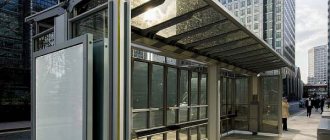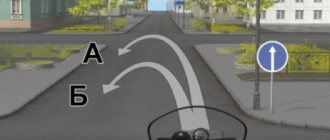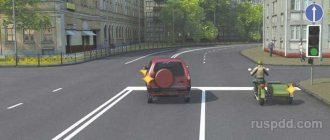We are on Twitter:
Login Registration
Automotive news
Rules for the movement of heavy trucks in the automatic weight control zone have been adopted. The Federal Tax Service has approved the application form for the death or destruction of a vehicle. In Russia, it is forbidden to disembark children without a ticket from buses. A new sign 6.22 has been introduced in the traffic rules - “photo and video recording” Testing for alcohol dependence has been postponed for another year. The Ministry of Health has updated the requirements for completing car first-aid kits, the Ministry of Transport has approved the procedure and terms for storing diagnostic maintenance cards. Obtaining permission for international transport will now be done in a new way. You can now check your MTPL policy for authenticity online. The Central Bank has set new tariffs for MTPL.
/ Legal articles on the topic of automobile law / Traffic rules and safety issues / Do I need to yield to a bus leaving a stop?
Do I need to yield to a bus leaving a stop?
Drivers living in large cities almost every day face a situation when, while driving in their lane to the right of a public transport stop, a bus or minibus starts to pull out onto the road.
Unfortunately, many drivers still do not know how to behave in this case. Today we will analyze this situation from a legal point of view so that, after reading this article, you clearly know who must give way - the bus or the car .
The bus leaves the stop - who should give way?
To answer this question, we will look at the motorist’s main reference book – the Traffic Rules of the Russian Federation.
Paragraph 18.3 of the traffic rules literally reads as follows: “In populated areas, drivers must give way to trolleybuses and buses starting from the designated stopping place. Drivers of trolleybuses and buses can start moving only after making sure that they are given way.”
As we can see, this provision of the Rules enshrines not only the obligation of the car driver to give way to public transport, but also the obligation of the bus (trolleybus) driver to leave the stop on the lane only after they are convinced that they are being let through.
Important! Public transport has priority when leaving a stop only if the stop has a designation established in accordance with the law (sign or special markings). A bus entering an adjacent lane in another place (for example, from the side of the road) does not create an obligation for drivers of passing vehicles to give way.
The next question that interests many drivers is who is to blame if the car does not allow the bus leaving the stop to pass and an accident occurs?
Judicial practice interprets such situations, as a rule, not in favor of car drivers. However, each case is individual and certain nuances can play an important role. For example, it often happens that a bus begins to leave a stop just at the moment when the next car in the adjacent lane is almost level with it, or without indicating its maneuver with a turn signal. In this situation, the guilt of the car owner is not as obvious as public transport drivers sometimes try to imagine.
Do you want to get valuable advice from a car lawyer regarding a specific accident? to the online consultant of our website, describe your situation, leave your contact information and wait for a response
The bus leaves the stop
Question. The bus stop is located in the pocket. I'm driving in the right lane, but I can't change lanes to the left because other cars are driving next to me on the left. A minibus (minibus) departs from the stop. Should she give way?
Answer. Yes, it is necessary to give way to a minibus leaving a stop if the event takes place in a populated area. This requirement is specified in clause 18.3 of the Traffic Regulations. The same clause of the traffic rules obliges drivers of route vehicles to make sure that they give way.
A route bus (minibus) is a route vehicle because it moves along a set route with designated stops. Why this is so can be read in the article Priority of public transport.
If a regular bus (minibus) pulls away from a stop and at the same time blocks your path (this happens when you are moving in the far right lane), then common sense dictates that you need to slow down and give way to this bus (minibus) at least for the sake of to avoid a collision.
Why does it happen that minibus drivers sometimes don’t look at the road when leaving a stop? - let them answer this question themselves. This is not a complaint against all drivers, but this fact does exist.
In fact, the reasons for such actions are not important. The driver is carrying passengers - you never know what can happen there, inside the bus. He has to be distracted by both the road and what is happening inside the bus.
You, in turn, while driving your own car, need to act according to the circumstances, taking into account in order to avoid an accident with a minibus (bus) leaving the stop.
If you see that a bus is leaving a bus stop ahead of you, then it is advisable to either reduce the speed and “let it go” from the stop, as required by paragraph 18.3, or change lanes to the left, into the adjacent lane, and continue moving along it, if possible.
When changing lanes, you must remember that in accordance with paragraph 8.4 of the traffic rules, the one who is changing lanes yields. When changing lanes at the same time, the one on the right has the advantage. For details, see the article Simultaneous rebuilding. Theory and practice.
It is also necessary to take into account the fact that a route vehicle (both a bus and a trolleybus) can start moving directly from the stop and change lanes immediately into the second row. This may be related to the further direction of the route.
In such circumstances, it is also necessary to give way to a bus leaving a stop and changing lanes to the second row. A similar issue is discussed in the article Driving past a bus stop.
If an accident occurs between your car and a shuttle bus at the moment when the bus is leaving the MTS stop, the culprits will be determined by the nature of the collision.
Your fault in the accident will be 100%, since you did not give way, but the fault of the bus driver will be considered according to the circumstances. Often the fault in an accident is mutual.
The fact is that when talking about a possible road accident, any person operates with “possible” scenarios. And each collision is always concrete. Therefore, the culprit is found based on the specifics of each case.
It is important to take into account the circumstances of a particular situation and take the necessary measures to avoid getting into an accident. To do this, you need to constantly monitor the road situation.
Be careful while driving.
Do I need to let minibuses depart from a stop?
In this chapter we will try to answer another question that interests many drivers - is it necessary to give way to a minibus leaving a stop?
Formally speaking, in the traffic rules there are no such concepts as “minibus taxi” or “minibus”, but only says that the driver must give way to buses and trolleybuses leaving the stop.
Accordingly, the whole question is whether the minibus is a bus or not. Let's try to figure it out.
In accordance with the Technical Regulations of the Customs Union “On the safety of wheeled vehicles,” buses include vehicles of categories M2 and M3, used to transport passengers with more than 8 seats (not counting the driver).
Thus, it should be stated that minibuses plying the streets of our cities, in accordance with the law, fall under the concept of “bus”, and accordingly, drivers are also required to let a minibus leaving a stop pass.
What does the traffic regulations say?
Clause 18.3 of the Russian Federation Traffic Regulations states the following: “In populated areas, drivers must give way to trolleybuses and buses starting from the designated stopping place. Drivers of trolleybuses and buses can start moving only after making sure that they are given way.”
Drivers of other vehicles are required to comply with the requirements of this paragraph, regardless of the trajectory of public transport. At the same time, the responsibility of the bus drivers is not relieved: they are obliged to make sure that turning and changing lanes does not pose a danger.
Advantages for buses, trolleybuses and minibuses
Despite the fact that buses and trolleybuses have priority in populated areas, drivers of these vehicles cannot use it without making sure that other traffic participants are giving way to them. This point is also enshrined in the traffic rules.
A public transport driver can use priority if:
- he drives away from the stop, which is indicated by appropriate signs and markings;
- the maneuver is safe and other road users give way;
- Before starting the maneuver, the driver is obliged to notify others of his intention, that is, turn on the left turn signal.
Thus, buses, trolleybuses and minibuses need to pass only if the above conditions are met.
Do I need to let a bus depart from a stop outside a populated area?
We have decided on buses and minibuses in cities, and now we will figure out how things are on country roads, where there is also public transport and stops on the side of the road.
The traffic rules establish the obligation of drivers to give way to buses leaving a stop in a populated area, but nothing is said about a similar situation outside a populated area. This leads to an unambiguous conclusion that on a suburban highway, outside the city (village, town), public transport leaving from the stop has no advantage.
Traffic regulations requirements regarding the need to give way to buses and minibuses departing from a stop
The route vehicle must be allowed through! And this is not a whim of all those who want to ride this bus or minibus in the flow of traffic and forward to their goal, I apologize to the next stop, but a requirement of traffic rules.
18.3. In populated areas, drivers must give way to trolleybuses and buses starting from the designated stopping place. Drivers of trolleybuses and buses can start moving only after making sure that they are given way
This has already been discussed in more detail in another article on the site. Now about the case if this requirement is ignored, that is, simply do not let buses depart from stops.
Priority signs for route vehicles
The first advantage: a dedicated lane for route vehicles.
To designate them, use the signs 5.11, 5.13.1, 5.13.2, 5.14:
A road with a lane for route vehicles A lane for route vehicles Exiting onto a road with a lane for route vehicles Exiting onto a road with a lane for route vehicles
It should be separately noted that the MTS advantage is provided only if the following conditions are met:
- public transport is located in the territory of a city or other locality;
- to indicate a stop, sign 5.16 was used.
The tram, if there is an equal right of passage, has priority over other trackless vehicles. When leaving the tram from the Depot, the tram does not have priority over other road users.
The tram does not have an advantage over other road users, since it leaves the Depot. The tram has an advantage over other road users.
Passengers are disembarked and boarded at stops marked 5.16. Traffic rules clause 18.3. states that car drivers are required to give way to public vehicles that are leaving a stop.
In turn, drivers of public vehicles must make sure that the road is clear or that the right-of-way is being given way to them, and then they can start driving.
What does this mean in practice? If public transport is leaving a stop, and at that moment an accident occurs involving a trolleybus or bus, then both people who were driving will be considered to be at fault. The fact is that the driver of the car must give way to a bus or trolleybus, because the transport starts moving from the stop. And the bus driver had to first make sure that he was allowed through, and only then start moving.
A bus leaving a stop—does it need to yield and in which lane?
18.3. In populated areas, drivers must give way to trolleybuses and buses starting from the designated stopping place. Drivers of trolleybuses and buses can start moving only after making sure that they are given way.
How much ambiguity is there in this paragraph of the Rules, would you agree? As we see, the drafters of the traffic rules extended the responsibility to both opposing drivers of vehicles, with the main goal, of course, being road safety. From this point it is also unclear what model of behavior to choose if a bus leaves a stop immediately into the second, third and further lanes, for what reasons does it leave there and how.
But the ambiguous becomes unambiguous if we consider the main goal of traffic rules - ensuring road safety. Simply put, you need to give in regardless of the duty, but to ensure such security. To put it even more simply, the rule “give way to a fool” is applicable here for drivers of both vehicles: both the driver of the car who is ordered or not ordered to give way to a bus leaving the stop, and the driver of this bus himself.
But if we’re talking about traffic rules, then let’s figure it out! Firstly, paragraph 18.3 contains the phrase “start of movement”, which is not defined in the traffic rules. And, driving further than the first lane, we can say that the bus is changing lanes after it has started moving.
8.4. When changing lanes, the driver must give way to vehicles moving in the same direction without changing direction. When simultaneously changing lanes of vehicles moving in the same direction, the driver must give way to the vehicle on the right.
It turns out that, on the one hand, 18.3 obliges you to give way to buses and trolleybuses, without specifying which lane they start moving into; on the other hand, clause 8.4. obliges the driver of a bus or trolleybus to give way to other cars (and motorcycles), changing lanes immediately beyond the first lane.
Meanwhile, many lawyers, as well as judges, believe that the start of movement can continue until the bus or trolleybus “levels out” to straight motion.
Therefore, in practice, in order to avoid controversial situations after the possibility of getting into an accident, this is exactly the case when it is better to be on the safe side and follow the three D rule. But if such a situation occurred, then everything will depend on the specific nature of the accident: which of the participants was more likely to prevent the accident, who had more arguments in favor of priority travel, and so on.










